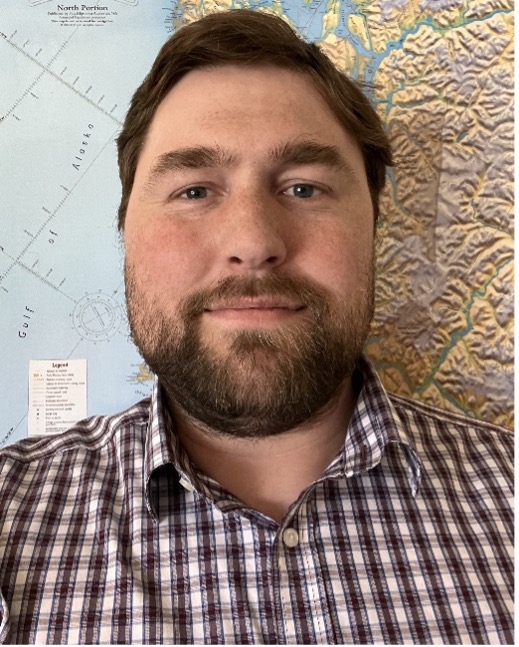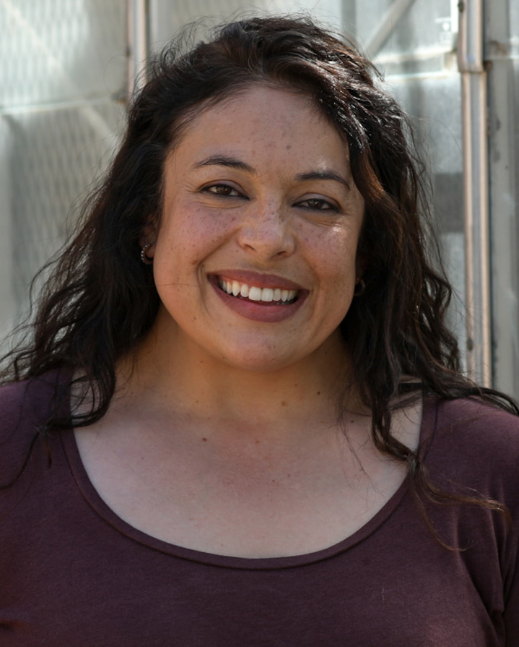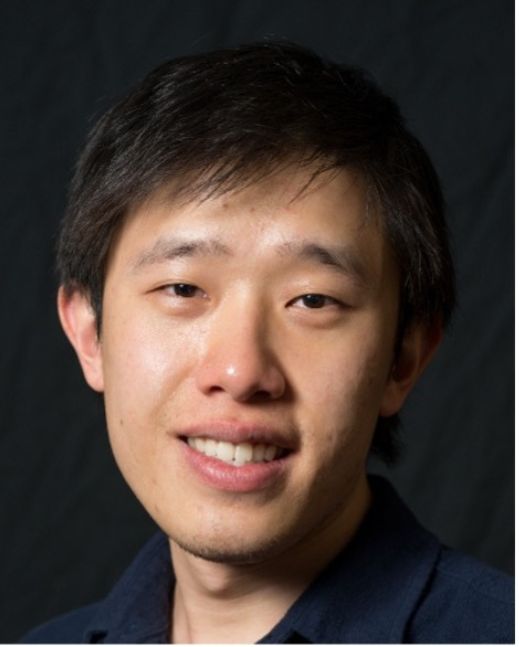CAIL | Chemical Analysis and Instrumentation Laboratory
Welcome to the webpage for the Chemical Analysis and Instrumentation Laboratory (CAIL) at New Mexico State University. We are an analytical user facility available for researchers at NMSU and beyond. The lab is supported by the Research Cores Program as part of VPR office and through affiliations with the Colleges of Agricultural, Commercial, and Environmental Science, Engineering, and Arts and Sciences.
If you are interested in using or learning more about the facility, please contact the director, Dr. Simeon Schum (skschum@nmsu.edu). The available instrumentation can be seen in the Instruments section, and the faculty and staff working in the facility can be seen in the People section.
What we do
CAIL contains a wide variety of analytical instrumentation from liquid and gas chromatography coupled mass spectrometry, to optical and thermal measurements, and elemental analysis. This allows us to support edge research in agriculture, engineering, science, and other disciplines. CAIL analyzes samples, assists with method development and data analysis, trains students, and maintains instrument performance and availability. CAIL is made sustainable through collaborative research projects and instrument use fees, which fund project supplies, staff availability, and instrument maintenance and improvement. To this end, CAIL supports proposal preparation through the acquisition of preliminary data and the development of budgets and method descriptions.
Targeted Analysis
Selective, sensitive methods using chemical standards to detect and quantify one or more predetermined target chemicals.
Nontargeted Analysis
Broad, qualitative methods using advanced data analytics to detect and identify as many chemical substances as possible.
Proteomics
Bottom-up approaches to identify proteins and characterize amino acid sequences and post-translational modifications after proteolytic digestion.
What we offer
CAIL comprises approximately 2,600 square feet of laboratory space, and 315 square feet of additional sample preparation space. It provides state-of-the-art mass spectrometry instrumentation and other research equipment for analyzing a wide variety of biological, environmental, and other samples, including the equipment necessary for sample and standards preparation. See Instruments section.
- Use the individual LabArchives sign-up link for each instrument (below) to book instrument time.
- If you need assistance in deciding how best to do your analysis, please direct your questions to the Director, Dr. Simeon Schum (skschum@nmsu.edu) and he will provide an answer himself, or direct you towards lab personnel who is best suited to answer your question.
- Faculty: If you are formulating a grant proposal and are interested in using this facility, please contact Director, Dr. Simeon Schum (skschum@nmsu.edu) during the planning stage to plan scope and budget.
Instruments
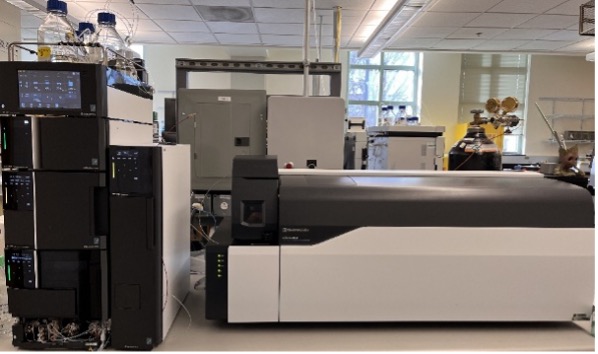
Shimadzu LC Triple Quad MS
- Skeen Hall W147
- Liquid chromatography coupled triple quadrupole mass spectrometer
- Sensitive multiple reaction monitoring (MRM)
- Mass ion scanning
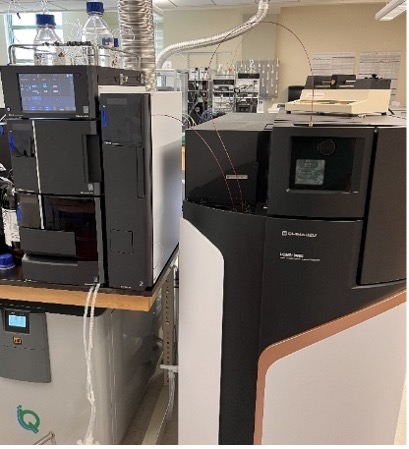
Shimadzu LC QTOF MS
- Skeen Hall W147
- Liquid chromatography quadrupole time-of-flight mass spectrometer
- Molecular weight determination
- Structural elucidation
- Metabolomic profiling
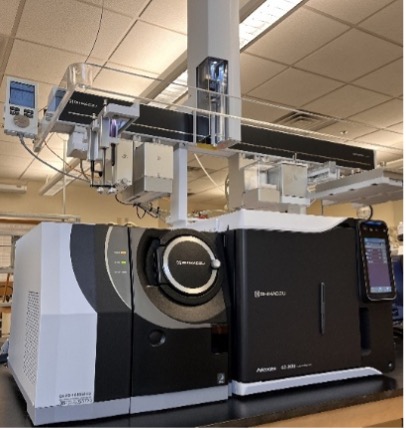
Shimadzu GCMS TQ8050 NX Triple Quad MS
- Skeen Hall W121
- Gas chromatography
- Triple quadrupole mass spectrometer
- Multiple reaction monitoring (MRM)
- General mass ion scanning
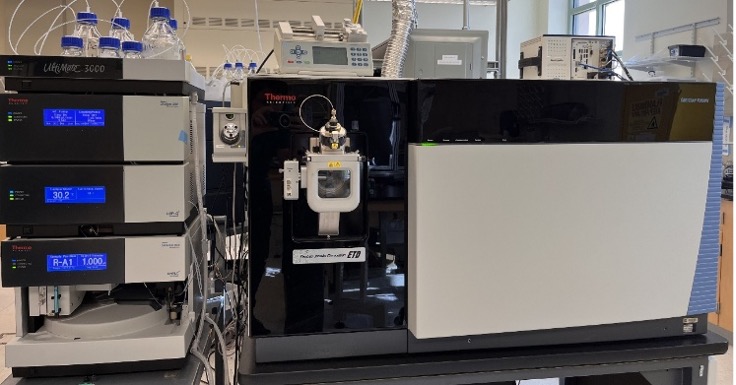
Orbitrap Fusion Tribrid High-Resolution MS
- Skeen Hall W 147
- High-resolution mass spectrometer
- Micro- or nano-flow liquid chromatography
- Non-targeted analysis of complex samples
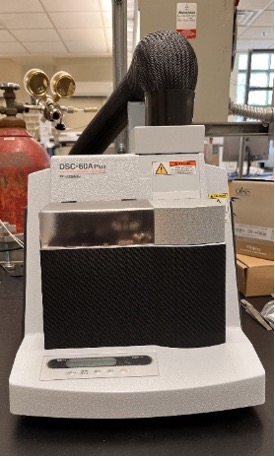
Shimadzu DSC 60A Plus
- Skeen Hall W121
- Thermal analysis
- Measure phase transitions, crystallization, and thermal stability of materials
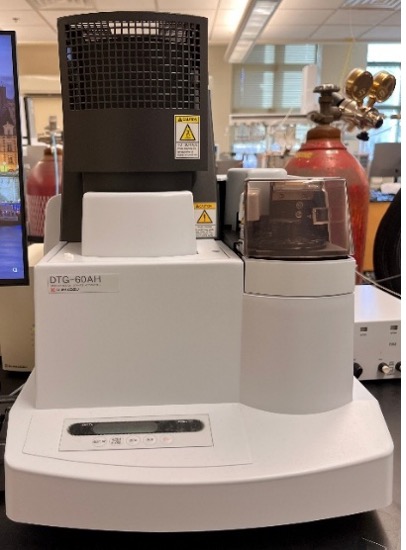
Shimadzu DTG-60AH
- Skeen Hall W121
- Simultaneous thermogravimetric analysis (TGA)
- Differential thermal analysis (DTA)
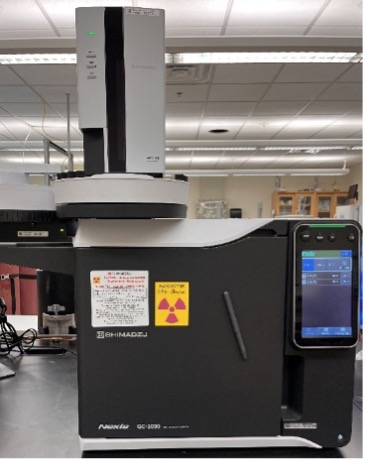
Shimadzu GC-ECD
- Skeen Hall W121
- Gas chromatography
- Electron capture detector (GC-ECD)
- Pesticide and herbicide residue analysis
- Liquid injection autosampler

Shimadzu GC FID/FTD
- Skeen Hall W121
- Gas chromatography with flame ionization detection (FID)
- Flame thermionic detection (FTD)
- Liquid injection autosampler
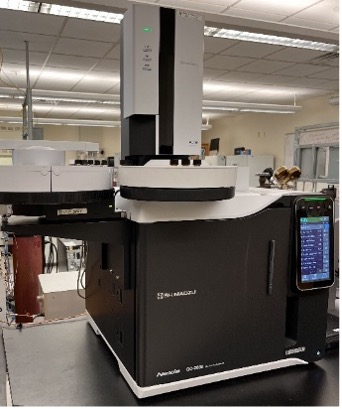
Shimadzu GC TCD
- Skeen Hall W121
- Gas chromatography with a thermal conductivity detector (GC-TCD)
- Liquid injection autosampler
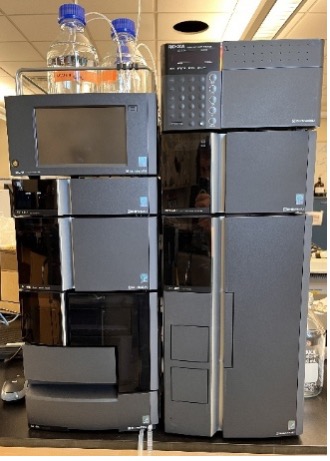
Shimadzu GPC System
- Skeen Hall W121
- Nexera Gel Permeation Chromatography (GPC) system
- Refractive index detector (RID)
- Photodiode array (PDA)
- Molecular weight distribution analysis of macromolecules
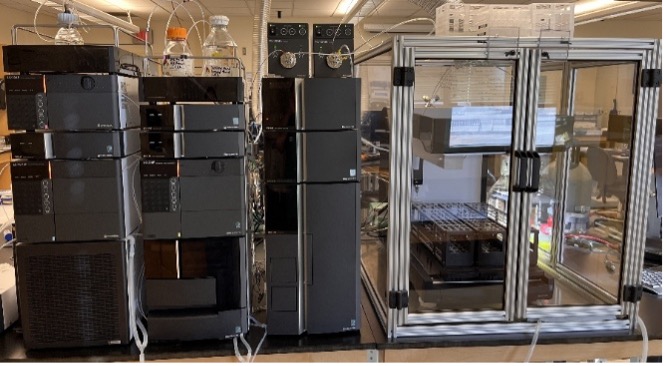
Shimadzu Preparatory SFC System
- Skeen Hall W147
- Preparative supercritical fluid chromatography (SFC) system
- PDA detector
- Purification and separation of natural products, lipids, and bioactive compounds
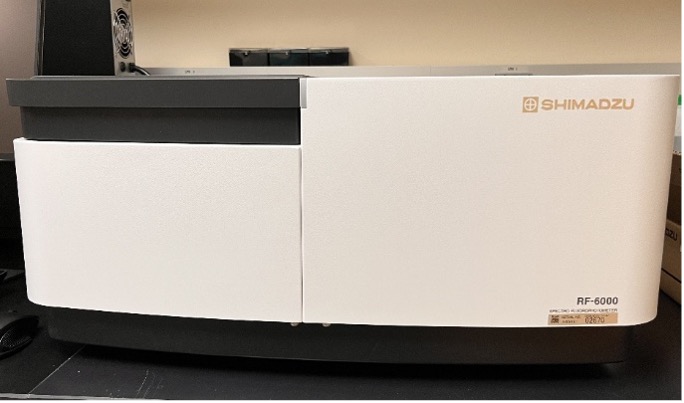
Shimadzu RF-6000 Spectro Fluorometer
- Skeen Hall W143
- Fluorescence spectrophotometer
- Highly sensitive detection of fluorescent compounds
- Optional integrating sphere
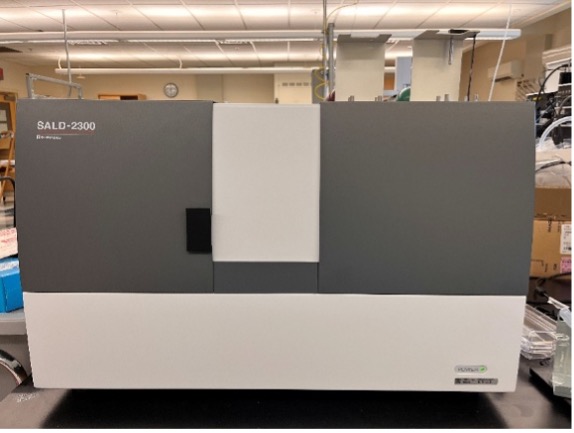
Shimadzu SALD-2300
- Skeen Hall W121
- Laser diffraction analyzer
- Size distribution of particles
- Precision agriculture

Shimadzu TOC-L, TNM, and SSM-5000
- Skeen Hall W121
- Total organic carbon (TOC) and total nitrogen measures
- Soil health, water quality, and organic matter composition (Shimadzu TOC Application Handbook)
- Solid sample module (SSM)
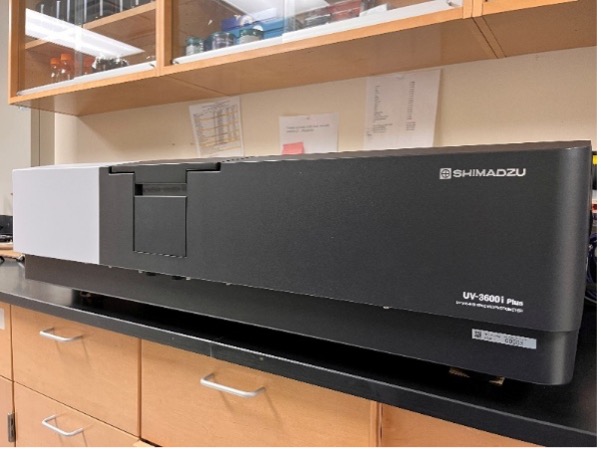
Shimadzu UV-Vis 3600 Plus
- Skeen Hall W143
- High-performance UV-Vis-NIR spectrophotometer
- Integrating sphere for accurate diffuse reflectance and transmittance measurements
- UV-Vis spectroscopy
- Optional integrating sphere
CAIL instruments can be reserved through the LabArchives Scheduler system, which maintains a calendar for each instrument, provides alerts for upcoming reservations, and uses a check-in/check-out system to log actual instrument use. Please contact Dr. Simeon Schum for more information and an invitation to the LabArchives Scheduler system.
Scheduling
- Instrument time can be scheduled one week in advance.
- All reservations must be approved by a CAIL Admin before use.
- When reserving time in LabArchive, fill in:
- Title: Name & group of the user.
- Description: Purpose (e.g., “standard curve & unknown quant run”), sample count, mobile phase, instrument settings (e.g., column, method).
- Time slots are available in 30-minute increments and overnight batch runs can be scheduled.
- Check-in and check-out via LabArchive upon arrival and departure.
- If an instrument is down for repair, missed reservations will be prioritized when rescheduling.
- Reservation changes/cancellations require admin approval.
Method and Sample Considerations
- Method development and training occur concurrently with CAIL Admin assistance.
- Users should have basic knowledge of sample preparation, composition, and relevant analysis conditions.
- Sample preparation expectations vary depending on the instrument being used, but generally:
- Use high purity solvents and proper extraction procedures.
- Avoid salts, particulates, and non-volatile buffers (e.g., Tris HCl, PBS) to prevent instrument clogging.
- Provide publications on your sample to expedite method development.
- Bring your own solvents and containers when required.
- Several training sessions may be needed before independent instrument use.
- Once a method is developed, batch sample runs can be scheduled to optimize lab time.
- Simple sample preparation may be done in the CAIL lab, but samples should generally be ready to run at the scheduled time.
- If you are uncertain about sample preparation, solvent compatibilities, or anything else, please talk with CAIL personnel prior to bringing your sample.
Billing and Costs
As an investment in faculty research support, the NMSU Office of Research provides a significant subsidy to the operation of the CAIL facility, including staff salary.
- CAIL usage can be billed on an hourly basis or can be based on a funded project budget (bulk).
- Each instrument has a specific hourly use rate that reflects its replacement and maintenance costs and supply costs.
- Staff salaries are partially included in hourly rates for projects that require staff involvement. , and staff salaries,
- Please contact Director, Simeon Schum (skschum@nmsu.edu) for more information.
- CAIL rate structure is reviewed every two years.
- Contact CAIL Admins with any questions or concerns.
- See you in the lab!
Acknowledgment Statement(s)
If you use Chemical Analysis and Instrumentation Laboratory (CAIL) SPARQ instrumentation, personnel, or resources for your research, please add the following acknowledgement statement to any publications or presentations that result from that assistance:
“We thank the CAIL staff, the Research Cores Program at NMSU, and the Shimadzu SPARQ instrument acquisition program for their assistance in data collection and analysis in this publication/presentation.”
If you use non-Shimadzu SPARQ equipment in CAIL, please use the following statement:
“We thank the CAIL staff and the Research Cores Program at NMSU for their assistance in data collection and analysis in this publication/presentation.”
If you use the Orbitrap, please also acknowledge the funding grant for it: “U.S. National Science Foundation, MRI-1626468”
If the point of contact for the work was Claudia Galvan, please also acknowledge the College of Agriculture, Consumer, and Environmental Science (ACES) with the following statement, in addition to the appropriate statement from above:
“We thank the College of Agriculture, Consumer, and Environmental Sciences for their support of personnel and facilities that assisted in this work.”
Please also include the name of your primary point of contact for analysis and assistance from CAIL and affiliated staff.
Who we are
CAIL is a multi-user facility, and component of the NMSU Research Cores Program, which provides NMSU researchers, NM-INBRE members, and their partners with broad access to state-of-the-art technology, training opportunities, and other research resources in support of the mission of NMSU Research, Creativity and Strategic Initiatives and the Office of the Vice President for Research.
People
Simeon Schum, Ph.D.
Director, Chemical Analysis & Instrumentation Laboratory
Research Cores Program
New Mexico State University
skschum@nmsu.edu
575-646-1144
Dr. Schum is the director of the Chemical Analysis and Instrumentation Laboratory (CAIL) which was recently updated through New Mexico State funds and the Shimadzu Sparq program to contain 4 million dollars worth of new Shimadzu analytical equipment in addition to pre-existing CAIL instrumentation. During his PhD work at Michigan Technological University (2013-2019) he was trained as an analytical chemist with a focus on high resolution mass spectrometry analysis of organic aerosol and other complex organic environmental mixtures. His primary research interests lie in improving the analysis and evaluation of non-targeted high resolution mass spectrometry data including through instrumental method development and the development of open-source code tools.
Claudia J. Galván, M.Sc
Research Lab Manager
College of Agricultural, Consumer, and Environmental Sciences
New Mexico State University
Claudia, a native of New Mexico and an NMSU alumna has over 10 years of experience in analytical chemistry. Her work with research spans several areas, including algal biology analysis with a focus on GCMS and GC-FID techniques. Claudia serves the Research CORE and NMSU’s Center of Excellence in Sustainable Food and Agricultural Systems.
Omar Holguin, Ph.D
ACES Faculty Advisor
Associate Professor
College of Agricultural, Consumer, and Environmental Sciences
New Mexico State University
William Bahureksa, Ph.D.
Post-Doctoral Researcher, Chemical Analysis & Instrumentation Laboratory
Research Cores Program
New Mexico State University
wbahurek@nmsu.edu
William Bahureksa grew up in Arizona and received a bachelor's in chemistry at the University of Arizona in 2016. William completed his PhD in Environmental Analytical Chemistry at Colorado State University and studied changes to organic matter in forested watersheds following wildfires by performing high resolution mass spectrometry and developing compositional analysis methods. William primarily implemented Fourier transform ion cyclotron resonance mass spectrometry and data science approaches to characterize molecular-level changes in both field and laboratory soil organic matter and model transformations during burning. At NMSU, William has been developing methods for per- and polyfluoroakyl substances (PFAS) and non-targeted analysis to characterize the effect of treatment on produced and brackish water and investigate potential reuse.
Maha Abutokaikah, Ph.D
Research Scientist, Chemical Analysis and Instrumentation Laboratory
Research Cores Program
New Mexico State University
mta35f@nmsu.edu
Maha Abutokaikah earned her bachelor's degree in Chemistry from Tabuk University and her doctorate from the University of Missouri–St. Louis, where she studied the fragmentation chemistries of small ions characterized in the gas phase using mass spectrometry. At NMSU, Maha has developed and optimized LC-MS workflows for complex metabolomics and proteomics applications, focusing on untargeted analysis.
Tanner Schaub, Ph.D.
Assistant Vice President for Research
Infrastructure and Partnerships
Office of Research, Creativity, and Economic Development
New Mexico State University
APLU CoR, Research Leadership Fellow
575-646-5156
Dr. Schaub leads the Infrastructure and Partnerships unit, which manages the sustainability and growth of NMSU’s research centers, institutes, and the Research Cores Program, to facilitate a unified flow of momentum and collaboration between internal and external partners. Schaub is a Research Professor whose research focuses on the application of advanced and high-resolution mass spectrometry systems to complex problems in water/environmental research, biological systems, alternative fuels, and materials science. The Infrastructure and Partnerships unit ensures the availability of research resources by aligning them with the university's broader goals, incorporating them into research funding initiatives, providing strategic oversight, and evaluating research priorities, budgets, and feasibility. Dr. Schaub also leads efforts to develop large funding proposals and initiatives, manages faculty start-up funding and cost-sharing, and administers the postdoc matching funds program.
Where we are
CAIL is located in the west wing of Skeen Hall on the NMSU main campus.
Addresses
New Mexico State UniversityChemical Analysis & Instrumentation Laboratory
Las Cruces, NM 88003
MSC 3RES
Las Cruces, NM 88003
